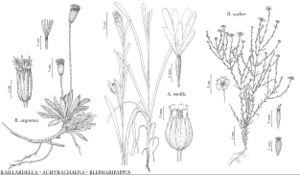Blepharipappus
Fl. Bor.-Amer. 1: 316. 1833.
| Taxon | Illustrator ⠉ | |
|---|---|---|
 | Raillardella argentea Achyrachaena mollis Blepharipappus scaber | Bee F. Gunn Barbara Alongi Marjorie C. Leggitt |
Annuals, 5–20 (–40+) cm. Stems ± erect (scabrous and, sometimes, hirsute, usually stipitate-glandular distally). Leaves mostly cauline; proximal opposite, most alternate; sessile; blades narrowly spatulate to linear, margins entire, faces scabrous, hirsute, strigose, sericeous, or villous (distal leaves usually stipitate-glandular as well). Heads radiate, borne singly or in open, corymbiform arrays. Peduncular bracts: pit-glands, tack-glands, and/or spines 0 at tips. Involucres turbinate to campanulate or hemispheric, 3–6+ mm diam. Phyllaries (2–) 3–5 (–8) in 1 series, ± lanceolate or oblanceolate, herbaceous, each ± 1/2 investing subtended floret proximally, abaxially ± hirsute and/or stipitate-glandular. Receptacles convex, glabrous, paleate (paleae falling, subtending all or most disc-florets, outer herbaceous, inner scarious). Ray-florets (2–) 3–5 (–8), pistillate, fertile; corollas whitish (nerved with purple abaxially). Disc-florets 6–25 (–60+), bisexual, fertile; corollas whitish, tubes shorter than or about equaling funnelform throats, lobes 5, deltate (anthers ± dark purple; styles ± hairy proximal to branches, branches ca. 0.2 mm). Cypselae ± obconic or terete (basal attachments ± central, faces ± villous, apices not beaked); pappi 0 or of 12–18 (–26) subulate fimbriate to ciliate or plumose scales. x = 8.
Distribution
nw North America
Discussion
Species 1.
Blepharipappus and members of Layia were once treated as congeneric; Layia appears to be more closely related to Lagophylla than to Blepharipappus, based on molecular phylogenetic data (S. Carlquist et al. 2003).
Selected References
None.